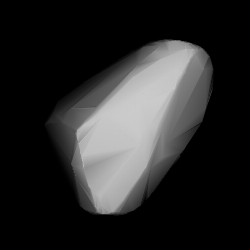Astronomy:1912 Anubis
 Modelled shape of Anubis from its lightcurve | |
| Discovery[1] | |
|---|---|
| Discovered by | C. J. van Houten I. van Houten-G. Tom Gehrels |
| Discovery site | Palomar Obs. |
| Discovery date | 24 September 1960 |
| Designations | |
| (1912) Anubis | |
| Pronunciation | /əˈnjuːbɪs/[4] |
| Named after | Anubis (Egyptian deity)[2] |
| 6534 P-L · 1938 DJ2 1943 DD · 1968 HQ | |
| Minor planet category | main-belt · Koronis[3] |
| Orbital characteristics[1] | |
| Epoch 4 September 2017 (JD 2458000.5) | |
| Uncertainty parameter 0 | |
| Observation arc | 74.27 yr (27,127 days) |
| |{{{apsis}}}|helion}} | 3.1736 AU |
| |{{{apsis}}}|helion}} | 2.6387 AU |
| 2.9061 AU | |
| Eccentricity | 0.0920 |
| Orbital period | 4.95 yr (1,810 days) |
| Mean anomaly | 154.97° |
| Mean motion | 0° 11m 56.04s / day |
| Inclination | 3.1576° |
| Longitude of ascending node | 76.223° |
| |{{{apsis}}}|helion}} | 2025-Jun-23 |
| 317.02° | |
| Physical characteristics | |
| Mean diameter | 10.28 km (calculated)[3] 10.407±0.952 km[5] |
| Rotation period | 4.626±0.001 h[3][6] 4.628±0.0012 h[6] |
| Geometric albedo | 0.24 (assumed)[3] 0.382±0.250[5] |
| S[3] | |
| Absolute magnitude (H) | 11.406±0.001 (R)[6] · 11.57[5] · 11.8[1] · 12.11[3] · 12.20±0.19[7] |
1912 Anubis (prov. designation: 6534 P-L) is a stony Koronis asteroid from the outer region of the asteroid belt, approximately 10 kilometers (6.2 miles) in diameter. It was named after the Egyptian deity Anubis.[2]
Orbit and classification
The S-type asteroid is a member of the Koronis family, a group consisting of about 200 known bodies. It orbits the Sun in the outer main-belt at a distance of 2.6–3.2 AU once every 4 years and 11 months (1,810 days). Its orbit has an eccentricity of 0.09 and an inclination of 3° with respect to the ecliptic.[1]
Discovery
Anubis was discovered on 24 September 1960, by the Dutch and Dutch–American astronomers Ingrid and Cornelis van Houten at Leiden, and Tom Gehrels, who took the photographic plates at Palomar Observatory, California.[8] On the same night, the trio of astronomers also discovered 1923 Osiris, 1924 Horus and 5011 Ptah, also named after Ancient Egyptian deities.
The survey designation "P-L" stands for Palomar–Leiden, named after Palomar Observatory and Leiden Observatory, which collaborated on the fruitful Palomar–Leiden survey in the 1960s. Gehrels used Palomar's Samuel Oschin telescope (also known as the 48-inch Schmidt Telescope), and shipped the photographic plates to Ingrid and Cornelis van Houten at Leiden Observatory where astrometry was carried out. The trio are credited with the discovery of several thousand minor planets.[9]
Naming
This minor planet was named after Anubis, the jackal-headed Egyptian god and protector of the dead.[2] The approved naming citation was published by the Minor Planet Center on 1 November 1979 (M.P.C. 5013).[10]
Physical characteristics
According to the survey carried out by NASA's Wide-field Infrared Survey Explorer with its subsequent NEOWISE mission, Anubis measures 10.407 kilometers in diameter and its surface has an albedo of 0.382,[5] while the Collaborative Asteroid Lightcurve Link (CALL) assumes a standard albedo for stony members of the Koronis family of 0.24, and calculates a diameter of 10.28 kilometers with an absolute magnitude of 12.11.[3]
In 2010 and 2012, two rotational lightcurves of Anubis were obtained from photometric observations at the Palomar Transient Factory in California. Lightcurve analysis gave a rotation period of 4.626 and 4.628 hours with a brightness amplitude of 0.47 and 0.18 magnitude, respectively ({{{1}}}).[6] CALL adopts the shorter period of 4.626 hours.[3]
References
- ↑ 1.0 1.1 1.2 1.3 "JPL Small-Body Database Browser: 1912 Anubis (6534 P-L)". Jet Propulsion Laboratory. https://ssd.jpl.nasa.gov/tools/sbdb_lookup.html#/?sstr=Anubis. Retrieved 1 July 2017.
- ↑ 2.0 2.1 2.2 Schmadel, Lutz D. (2007). "(1912) Anubis". Dictionary of Minor Planet Names – (1912) Anubis. Springer Berlin Heidelberg. p. 153. doi:10.1007/978-3-540-29925-7_1913. ISBN 978-3-540-00238-3.
- ↑ 3.0 3.1 3.2 3.3 3.4 3.5 3.6 3.7 "LCDB Data for (1912) Anubis". Asteroid Lightcurve Database (LCDB). http://www.minorplanet.info/PHP/generateOneAsteroidInfo.php?AstInfo=1912%7CAnubis. Retrieved 10 December 2016.
- ↑ "Anubis". Anubis. Oxford University Press. http://www.lexico.com/definition/Anubis.
- ↑ 5.0 5.1 5.2 5.3 Masiero, Joseph R.; Mainzer, A. K.; Grav, T.; Bauer, J. M.; Cutri, R. M.; Nugent, C. et al. (November 2012). "Preliminary Analysis of WISE/NEOWISE 3-Band Cryogenic and Post-cryogenic Observations of Main Belt Asteroids". The Astrophysical Journal Letters 759 (1): 5. doi:10.1088/2041-8205/759/1/L8. Bibcode: 2012ApJ...759L...8M. http://adsabs.harvard.edu/cgi-bin/bib_query?bibcode=2012ApJ...759L...8M. Retrieved 10 December 2016.
- ↑ 6.0 6.1 6.2 6.3 Waszczak, Adam; Chang, Chan-Kao; Ofek, Eran O.; Laher, Russ; Masci, Frank; Levitan, David et al. (September 2015). "Asteroid Light Curves from the Palomar Transient Factory Survey: Rotation Periods and Phase Functions from Sparse Photometry". The Astronomical Journal 150 (3): 35. doi:10.1088/0004-6256/150/3/75. Bibcode: 2015AJ....150...75W. http://adsabs.harvard.edu/cgi-bin/bib_query?bibcode=2015AJ....150...75W. Retrieved 10 December 2016.
- ↑ Veres, Peter; Jedicke, Robert; Fitzsimmons, Alan; Denneau, Larry; Granvik, Mikael; Bolin, Bryce et al. (November 2015). "Absolute magnitudes and slope parameters for 250,000 asteroids observed by Pan-STARRS PS1 - Preliminary results". Icarus 261: 34–47. doi:10.1016/j.icarus.2015.08.007. Bibcode: 2015Icar..261...34V. http://adsabs.harvard.edu/cgi-bin/bib_query?bibcode=2015Icar..261...34V. Retrieved 10 December 2016.
- ↑ "1912 Anubis (6534 P-L)". Minor Planet Center. https://www.minorplanetcenter.net/db_search/show_object?object_id=1912. Retrieved 10 December 2016.
- ↑ "Minor Planet Discoverers". Minor Planet Center. 24 April 2016. https://www.minorplanetcenter.net/iau/lists/MPDiscsNum.html. Retrieved 10 December 2016.
- ↑ "MPC/MPO/MPS Archive". Minor Planet Center. https://www.minorplanetcenter.net/iau/ECS/MPCArchive/MPCArchive_TBL.html. Retrieved 10 December 2016.
External links
- Asteroid Lightcurve Database (LCDB), query form (info )
- Dictionary of Minor Planet Names, Google books
- Asteroids and comets rotation curves, CdR – Observatoire de Genève, Raoul Behrend
- Discovery Circumstances: Numbered Minor Planets (1)-(5000) – Minor Planet Center
- 1912 Anubis at AstDyS-2, Asteroids—Dynamic Site
- 1912 Anubis at the JPL Small-Body Database
 |

